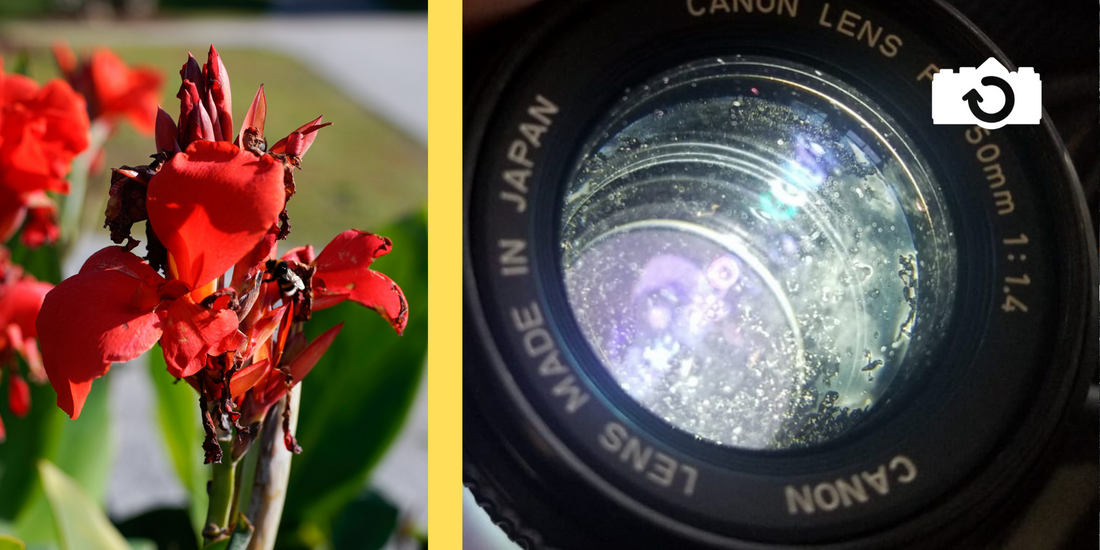Every day we receive messages from people asking about how a dirty lens will affect image quality.
- Can I shoot with a dirty lens?
- How much will dust affect my photos?
- Do cheap filters degrade image quality?
- How much haze is too much haze?
- I have a scratch, is my lens ruined?
So let’s set the record straight on dirty lenses and how different defects affect the quality of your photos.
What is lens dust?
Dust can get into lenses in innumerable ways, and is the most common cause of a dirty lens. In order to focus, change apertures, etc. a lens cannot be perfectly sealed. Some lenses come close, but dust will sneak in no matter what. Dust can be dirt, debris, chipped paint, or even hair from the environment that finds its way between the glass elements.
What is lens fungus?
Fungus comes from a combination of dust and moisture trapped between the glass elements. Life begins to grow in the mixture, and the fungus will slowly grow across lens elements. Eventually, even if the fungus is cleaned, it can cause irreparable damage to lens coatings.
What is lens separation?
Separation is the result of adhesive breaking down. Certain lens elements are glued to other elements with special adhesives that are invisible under normal circumstances. As the elements separate, however, the adhesive can cause the lens to reflect light differently, often leaving the lens with a rainbow pattern, similar to oil on water.
Testing Varying Levels of Dirty Lenses
For the purposes of this unscientific experiment, I played with a few lenses with moderate to severe issues, shooting the same images for an easy comparison of the results. The camera used is a Sony A7R, and all shots were taken at f4, ISO200 in an attempt to regulate things a bit.
Canon EF 75-300mm f4-5.6 II
This Canon EF 75-300mm f4-5.6 II would not have passed our quality control checks. Quite a dirty lens. The dust is clearly visible when you shine a light directly through, although it's actually hard to see with the naked eye.

 |
 |
 |
 |

This level of dust, although we point it out on the site whenever it shows up, is not something noticeable in photos. Buy with confidence as long as the seller has a satisfactory checking process like ours.
Carl Zeiss Jena 5cm f1.5 Sonnar
These next photos come from a Carl Zeiss Jena 5cm f1.5 lens for M39, or Leica Thread Mount. This is the oldest dirty lens I tested for this article, and is riddled with scratches, has light haze, and even some coating damage towards the edge of the frame.

As you can see, there's quite a bit of damage on this 80-90 year old lens. How will this affect the images?
 |
 |
 |
 |

Clearly, this lens has lost quite a bit of sharpness and contrast due to damage, but it’s most noticeable when shooting into direct light. Under less intense circumstances, the shortcomings of the lens can be more attributed to age than damage. The sharpness and coatings of these lenses simply aren’t on par with modern equivalents, or even lenses from 30-40 years ago. That being said, you can see how serious scratching can impact a lens’ performance, even in the case of the legendary Carl Zeiss.
Canon 50mm f1.4 FDn
I’ll show this next set of images, taken with a Canon 50mm f1.4 FDn lens, and let you guess what’s wrong with the lens.
 |
 |
 |
 |

Having trouble? Think I’m trying to trick you by sneaking a really clean, nice lens into the mix? Well, you’d be wrong, because this lens is full of fungus of all kinds, as well as a bit of haze. This is something that would definitely affect the selling price, as well as warrant a repair for a lens like the Canon 50mm f1.4, but you can see that the photos look wonderful. There may be a bit less contrast than normal, but it’s hard to argue that this lens, fungus and all, isn’t usable.

I don’t know about you, but I think the damage to this lens is just as bad as what happened to the Carl Zeiss we just looked at. And yet, the photos remain better than usable. It goes to show that a quality lens will retain its quality for far longer than you may expect, even in the face of fungus, haze, scratching, and whatever else life throws at it.
Sigma 35-70mm f2.8-4
Next up, a Sigma 35-70mm f2.8-4 zoom lens for Canon FD. This one is plagued by considerable haze in an interesting donut shape around the edge of the frame.

Weird, right? Something like this would definitely affect the value of the lens, and can come from a number of things like internal glue or paint wearing off, any amount of liquid getting into the lens and evaporating, and some other causes as well. It actually looks kind of pretty, for a dirty lens, but we’re curious about how it affects the final images.
 |
 |
 |
 |

Like the Carl Zeiss, it’s clear that these images were affected by the lens’ issues. You can see the haze when shot into direct sunlight and there’s a general lack of sharpness and contrast. However, when not shot directly into the sun (for example, the photo with the flower) I think you’d be hard-pressed to say confidently that the lens has pretty severe donut-shaped haze.
Sony 24-70mm f2.8 Carl Zeiss T* Vario-Sonnar
Next up is a lens we bought elsewhere, and had shipped to us just for this test. Try again to guess what the issue could be.
 |
 |
 |
 |

Can’t do it? This is the pro-grade Sony 24-70mm f2.8 Vario-Sonnar T* for Sony A, a beast of a lens that’s sharp enough to resolve on almost any sensor and create wonderful photos. Even when the front element looks like someone scooped a chunk out of it.

The separation on display here is so intense that that inner element has formed a hole near the edge. The element just isn’t there anymore. And yet, are the photos any different? Even zoomed in halfway to 50mm, I just don’t see it. The photos look great, crisp and well-exposed even though they were taken on a different day in harsher light.
Just compare the Zeiss's results to other modern lenses we tested, like the Canon EF 75-300mm. The Canon, despite its dust, did a great job resisting flare and resolving individual leaves. The Zeiss, though, completely blows it out of the water in terms of sharpness despite being irreparably damaged.
Canon EF-S 18-55mm f3.5-5.6 III
Our final lens is a Canon EF-S 18-55mm kit lens. Of course, this is a lens for APS-C sensors, so there will be serious vignetting. I left it all in for the sake of this comparison, but the lens is behaving as it should. Now for the samples!
 |
 |
 |
 |

Aside from the vignette, could you tell what’s wrong with this lens? No? Well, let me pull back the curtain and show you.

This lens’ aperture mechanism is broken, leaving a piece hanging in frame most of the time. The reality is, though, that you can see basically no evidence of it unless you take a test shot on a sample background and zoom in to 100%.
Conclusions after Testing Dirty and Damaged Lenses
So there you have it. Lenses with pretty severe issues and some photos to go along with them. What have we learned? While it's fair for the price of a well-used lens to be lower, it doesn't have to mean that the image quality will be lower.
It's very likely that lenses with decades of use and some internal damage, will have lower sharpness and contrast than an unused lens. In most situations, though, it's very difficult to notice the difference.
Often, what's more important is how the lens was to begin with. A well-made lens with high optical qualities at the start, will have higher chances of performing well with some, dirt, haze, fungus, or other damage (compared to an equally damaged lesser quality lens).
Additionally, real life is not a test background. Reality is much more organic than a checkered grid, and a lens can create beautiful images without being perfect.
Clearly I’m not advocating we all shoot exclusively on fungus-filled lenses. That would put us at Kamerastore out of business. Hopefully we can all understand a big more about lens damage and what it means to be "usable".
If you're interested in picking up a (possibly) dirty lens or two, check out our Not Passed -items!
This article was originally published on 23.9.2020






